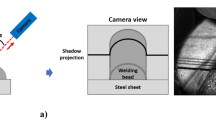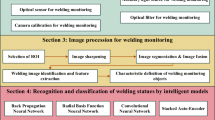Abstract
This paper presents a new generation of system for pressure vessel and shipbuilding. Typical pressure vessel and ship building weld joint preparations are either traditional V, butt, fillet grooves or have narrow or semi narrow gap profiles. The fillet and U groove are prevalently used in heavy industries and shipbuilding to melt and join the parts. Since the wall thickness can be up to 6 in. or greater, welds must be made in many layers, each layer containing several passes. However, the welding time for the conventional processes such as submerged arc welding (SAW) and flux cored arc welding (FCAW) can be many hours.
Although SAW and FCAW are normally mechanized processes, pressure vessel and ship structures welding up to now have usually been controlled by a full time operator. The operator has typically been responsible for positioning each individual weld run, for setting weld process parameters, for maintaining flux and wire levels, for removing slag and so on.
The aim of the system is to develop a high speed welding system with multi-torch for increasing the production speed on the line and to remove the need for the operator so that the system can run automatically for the complete multi-torch multi-layer weld. To achieve this, a laser vision sensor and a special image processing algorithm have been made. Also, the multi-torch welding system can be applicable for fine grained steel because of the high welding speed and lower heat input compared to a conventional welding process.
Similar content being viewed by others
References
Beattie RJ, Cheng SK, Logue, PS (1988) The use of vision sensors in multipass welding applications. Weld J 67(11):28–33
Moon HS, Beattie RJ (2001) Adaptive multitorch multipass SAW. Int J. KWS 1(1):1–7
Moon HS, Beattie RJ (2002) A fully automatic adaptive pressure vessel welding system. AWS, Chicago, IL
Pierre S, Martin DL (1989) Joint recognition and tracking for robotic arc welding. IEEE Trans Syst Man Cybern 15(4):714–728
Author information
Authors and Affiliations
Corresponding author
Rights and permissions
About this article
Cite this article
Moon, HS., Kim, Y. & Beattie, R. Multi sensor data fusion for improving performance and reliability of fully automatic welding system. Int J Adv Manuf Technol 28, 286–293 (2006). https://doi.org/10.1007/s00170-004-2359-1
Received:
Accepted:
Published:
Issue Date:
DOI: https://doi.org/10.1007/s00170-004-2359-1




